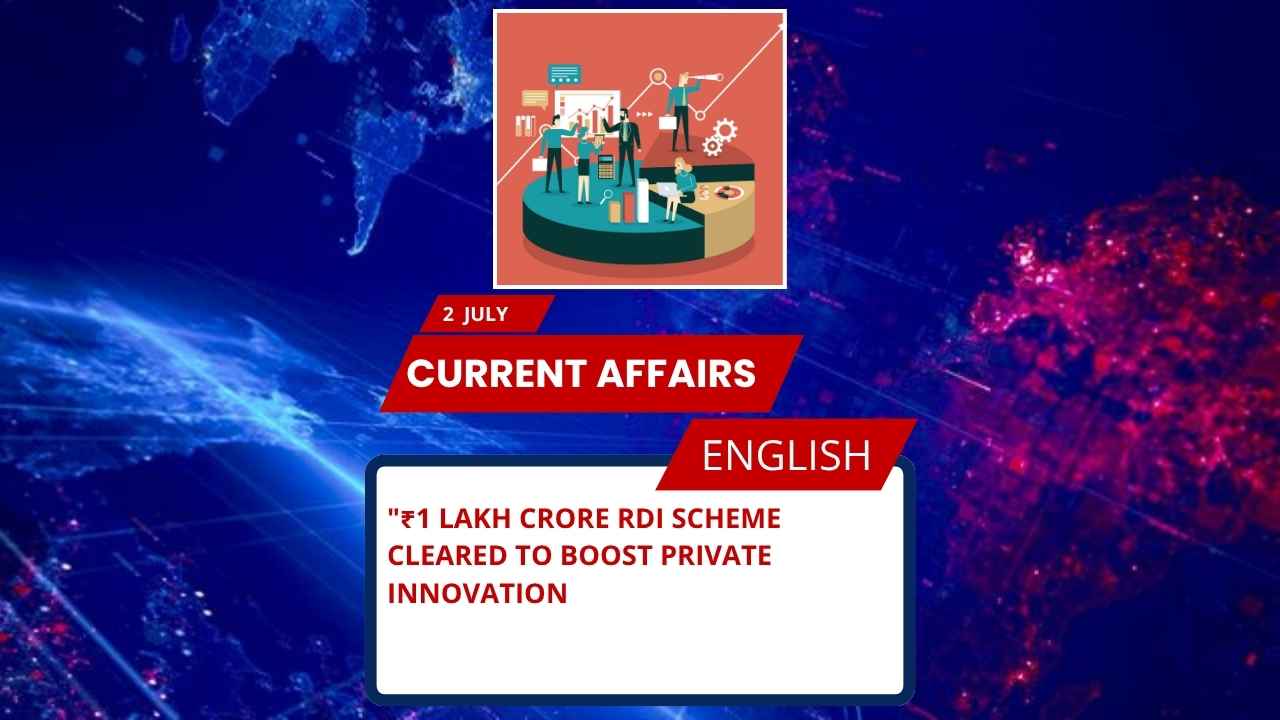
Key Points for SSC/UPSC and Other Govt Exams
- Scheme Name: Research Development and Innovation (RDI) Scheme
- Total Outlay: ₹1 lakh crore
- Launched by: Union Cabinet (Chaired by PM)
- Nodal Department: Department of Science and Technology
- Key Objective: Promote private sector-led innovation in strategic and sunrise sectors
- Special Fund Setup: Within Anusandhan National Research Foundation (ANRF)
- Funding Model: Two-tier – Special Purpose Fund and second-level fund managers
- Support Type: Concessional loans, equity, long-term financing
- Target Sectors: High Technology Readiness Levels (TRL), Deep-tech, Emerging Technologies
- Monitoring Body: Empowered Group of Secretaries (headed by Cabinet Secretary)
Full Details: ₹1 Lakh Crore RDI Scheme to Drive Private Innovation in India
The Union Cabinet, led by Prime Minister Narendra Modi, has approved the ambitious Research Development and Innovation (RDI) Scheme with an outlay of ₹1 lakh crore, aiming to catalyze India’s private sector participation in research and innovation.
This initiative is a strategic move to position India as a global leader in emerging and critical technologies by supporting long-term financing or refinancing to private companies—especially those engaged in high-tech innovation.
Two-Tier Funding Architecture
The RDI Scheme will operate via a two-tier structure:
- Special Purpose Fund (SPF) within Anusandhan National Research Foundation (ANRF) to act as the primary custodian of funds.
- Second-level Fund Managers will distribute these funds in the form of concessional loans or equity, especially to startups and technology ventures.
Strategic Oversight and Implementation
- Governing Board of ANRF chaired by the Prime Minister to provide policy direction.
- Executive Council of ANRF to approve guidelines and select fund managers/projects.
- Empowered Group of Secretaries, led by the Cabinet Secretary, to monitor and ensure efficient execution.
Core Objectives
- Encourage private R&D investment in sunrise and strategic sectors
- Address funding barriers in private research
- Provide growth capital and risk funding for deep-tech sectors
- Enhance India’s global competitiveness and economic self-reliance
Deep-Tech Fund of Funds
The scheme also proposes the formation of a Deep-Tech Fund of Funds to support technology-based startups and ventures developing strategic or high-TRL innovations.
Important Organisation Mentioned
Anusandhan National Research Foundation (ANRF)
- Established: Under Science and Engineering Research Board (SERB) Amendment Bill, 2023
- Purpose: To promote high-quality research in science, technology, and innovation
- Chairperson: Prime Minister of India
- Parent Department: Department of Science and Technology
- Key Focus: Interdisciplinary research, innovation ecosystem strengthening
Exam-Oriented MCQs
Q1. What is the total financial outlay of the newly approved RDI Scheme by the Union Cabinet?
A. ₹10,000 crore
B. ₹50,000 crore
C. ₹1 lakh crore
D. ₹5 lakh crore
Answer: C. ₹1 lakh crore
Q2. Which body will act as the custodian of the Special Purpose Fund under the RDI Scheme?
A. NITI Aayog
B. DRDO
C. Anusandhan National Research Foundation
D. Ministry of Finance
Answer: C. Anusandhan National Research Foundation
Q3. Who will head the Governing Board of the ANRF?
A. Finance Minister
B. President of India
C. Prime Minister
D. Chief Economic Advisor
Answer: C. Prime Minister
Q4. Which department will serve as the nodal agency for implementing the RDI Scheme?
A. Ministry of Education
B. Department of Science and Technology
C. Ministry of Corporate Affairs
D. Ministry of Finance
Answer: B. Department of Science and Technology
Q5. What is the objective of the Deep-Tech Fund of Funds under the RDI Scheme?
A. Financing agricultural startups
B. Promoting traditional industries
C. Supporting technology-based ventures
D. Funding export-oriented units
Answer: C. Supporting technology-based ventures
UPSC Mains-Oriented FAQs with Model Answers
Q1. What are the objectives of the RDI Scheme, and how does it aim to transform India’s innovation ecosystem?
Answer:
The RDI Scheme is designed to strengthen private sector-led innovation by addressing long-standing funding gaps and enabling access to low or zero-interest financing for R&D initiatives. Its core objectives include promoting innovation in sunrise and strategic sectors, enhancing India’s global technology competitiveness, and ensuring economic security through technological self-reliance. By setting up a two-tier funding mechanism, it creates a dedicated flow of capital towards startups, high TRL projects, and critical technologies, ensuring private industry engagement in national innovation efforts.
Q2. How is the governance and fund distribution structure of the RDI Scheme designed to ensure efficiency and accountability?
Answer:
The RDI Scheme’s governance structure includes a Governing Board chaired by the Prime Minister, responsible for strategic oversight, and an Executive Council under the ANRF for approving projects and selecting fund managers. A Special Purpose Fund (SPF) will be managed within the ANRF, which will allocate funds to second-level fund managers who will disburse concessional loans or equity. Oversight is provided by an Empowered Group of Secretaries, led by the Cabinet Secretary, to monitor performance, select sectors, and ensure transparent implementation.
Q3. What role does the private sector play in the RDI Scheme, and why is its involvement crucial?
Answer:
The private sector plays a central role in the RDI Scheme as the primary beneficiary and driver of innovation. The scheme specifically targets private firms, startups, and technology ventures, enabling them to access long-term financing for high-risk, high-reward R&D projects. Private involvement is crucial as it introduces market efficiency, agility, and scalability into the innovation ecosystem and bridges the gap between research and commercial application, thus contributing to national growth and global competitiveness.
Q4. Discuss the significance of establishing the Deep-Tech Fund of Funds in the context of India’s technology aspirations.
Answer:
The Deep-Tech Fund of Funds is a transformative step towards supporting frontier technology ventures in India. It recognizes the need for specialized, risk-tolerant capital for innovations in AI, semiconductors, biotechnology, aerospace, quantum computing, and other strategic areas. This fund ensures the availability of growth capital for early-stage startups operating in deep-tech domains, which typically face investment barriers due to their long gestation periods and high R&D costs. Its implementation aligns with India’s vision of becoming a technology-first economy and achieving strategic autonomy.
Q5. Evaluate the potential challenges that might arise during the implementation of the RDI Scheme.
Answer:
While the RDI Scheme is visionary, several implementation challenges may arise:
- Efficient Fund Allocation – Identifying competent fund managers and ensuring timely, merit-based disbursal.
- Private Sector Readiness – Limited capacity among smaller firms to undertake deep-tech R&D without technical mentoring.
- Monitoring and Accountability – Ensuring transparency and outcome-driven funding across all project stages.
- Coordination between Agencies – Seamless collaboration between DST, ANRF, fund managers, and oversight committees.
Addressing these challenges requires a robust digital monitoring framework, industry-academia collaboration, and active policy feedback loops.






